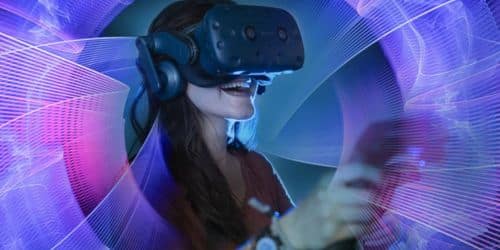The term “immersive experience” refers to the sensation of being completely submerged in a setting that is otherwise foreign to us. This could be accomplished in a digital setting, such as with VR goggles, or in a real-world setting, such as with a theme park experience that features audio-visual elements. Through the use of technology, an “immersive experience” submerges a person in a brand-new or enhanced world, improving daily life (by making it more interesting or rewarding). Frequently, they employ a network of interconnected technology. This article explains immersive experience design, disney immersive experience, and immersive experience companies. Also, get to know some immersive experience examples by reading through the article.
What Is an Immersive Experience?
The term “immersive experience” is often used to describe any event made possible by digital technology that seeks to recreate the sensation of being fully immersed in a real-world setting through the use of digital or simulated means. “Immersion” is a more nuanced idea that serves as the foundation for immersive experiences. Immersion originally meant submerging anything in the water. This sense of “immersion” has since been extended to describe computer-generated simulations.
One’s perceptions and sensations in the real world are completely supplanted by those in the virtual world during an immersive experience. As a result, one’s sense of physical self and awareness of it are both lessened.
What is Immersive Technology?
“Immersive experiences” are made possible by “immersive technology,” which seamlessly blends a user’s real-world surroundings with computer-generated elements. An interactive virtual world can serve as a realistic simulation. The user’s experience need not be realistic, and can instead take the form of a digital abstraction or fantastical user interface. Immersive technology is now used in retail, e-commerce, healthcare, adult entertainment, video games, art, entertainment, and interactive storytelling.
Immersive Experience Examples
What associations do you make with the term “immersive”? It evokes a wide range of responses from people. The beach, the pool, or the flotation tank can also provide the feeling of effortless relaxation for some people. Others escape into a fantasy world through books, museums, or movies. However, one way that tech-savvy individuals can immerse themselves is by using a mobile device, a video game console, a controller, or a head-mounted display. Check out some immersive experience examples:
#1. Virtual Reality (VR)
VR lets users engage with 3D computer-generated content. Virtual reality technologies immerse viewers with screens and controls. Virtual reality systems typically include a number of parts, including hardware (such as smartphones and VR goggles), software, a user interface, and human elements like perceptions, cognition, and emotions. comprise
VR users often use a headset like the Oculus Quest, Samsung Gear VR, or HTC Vive to access the content. Moreover, hand controllers can be incorporated into more interactive VR experiences, allowing users to do things like move around in the virtual world and interact with virtual items and other users.
#2. Augmented Reality
A smartphone’s camera and display can also be used to create an augmented reality (AR) experience, which superimposes computer-generated data onto the user’s view of the physical world. Instead of building a whole new virtual world as VR does, AR just adds to (or removes from) the one that currently exists.
Applications for augmented reality actually add layers of digital data to our physical surroundings. This indicates that, unlike VR, AR does not entirely recreate fake worlds to replace the real world with a virtual one. In contrast, augmented reality (AR) generally appears in front of a user’s eyes and overlays the surroundings with audio, video, and images, altering the user’s sense of what’s actually there.
#3. Projection-based AR
This kind of AR projects artificial light onto real-world surfaces, and in certain cases allows users to interact with it. Sci-fi films like Star Trek frequently also use this artificial light to create holograms.
#4. Mixed Reality
An improvement on augmented reality (AR), mixed reality (MR) incorporates virtual reality (VR) features. To create a more immersive experience than AR alone, VR typically integrates whole virtual items into the real environment rather than just adding information. Using Mixed Reality, people may make their own hologram content, share it with others, and work together on it. Powerful capabilities like mapping the environment, tracking gestures, and processing language for voice recognition are also part of MR. Industries that want to increase their operational efficiency through the use of holographic experiences are frequent users of MR technology.
#5. Digital Twins
Digital twins employ VR, 3D visual modeling, and data modeling to simulate a process, product, system, service, or real object. Data scientists create digital twins that are nearly identical to real-world gadgets in order to test out various scenarios before investing time, money, and manpower into creating and deploying the real thing.
Digital twins are most frequently employed in manufacturing or engineering for simulation purposes, changing how technologies like IoT, AI, and analytics are optimized. Mercedes employs digital twins to better its Formula One car and NASA to track and tune its satellites.
Disney Immersive Experience
Immersive Experience is a cutting-edge celebration that immerses you in the best Walt Disney Animation Studios productions, from the studio’s very first, ground-breaking features to the current generation of well-liked blockbusters. Just picture yourself entering the Encanto Casita with Mirabel, being at Pride Rock as Rafiki presents Simba, and watching the sunrise over the animal kingdom. Also, picture yourself riding into Zootopia with Judy Hopps on the train, or flying into the air with Aladdin and Jasmine in their magical carpet.
You can do it now! Indulge in the music, artwork, and animation from the studio that brought you “Frozen,” “The Little Mermaid,” “Big Hero 6,” and many more Disney classics as you commemorate their heritage.
Immersive Experience Design
The term “immersive experience design” is used to describe a wide range of design projects that aim to make people feel completely immersed in an encounter. This type of design utilizes virtual reality, augmented reality, and mixed reality to provide the impression that the user is actually interacting with a highly realistic computer-generated environment. One of the basics of excellent design, from the perspective of the designer, is keeping the user engaged and engrossed as they move through the experience.
It is essential to provide users with an experience that makes them feel as though they are actually a part of the world they are exploring. Consumers always want the most immersive experience they can get, especially when it comes to entertainment. In response to this demand, it can be seen that product manufacturers work to raise the screen-to-body ratio of their products, whether it be a phone, television, or laptop. Their major goal is to have as large a screen as possible in a given dimension, and this is where the trend of shirking bezels began, with the end goal of providing an immersive experience.
All of these fundamental components must be present for an experience to be considered really immersive, and either virtual reality (VR) or augmented reality can accomplish this (AR). Since Facebook bought oculus, the wide field of what we call virtual reality has matured quickly. However, the user is transported into action with virtual reality. Instead of looking at a flat screen, users are transported into immersive, interactive 3D environments. VR is great for gaming and media consumption, but it still hasn’t caught up to safety standards.
Elements to Look Out for in Immersive Experience Design
Here are some elements to look out for in immersive experience design:
#1. Audio
The use of sound can help immerse and maintain an audience’s attention in the experience’s reality. When done right, the sound is invisible, adding to the immersion and making the experience feel more genuine.
#2. Sight
The number of external stimuli experienced by the user must be minimized or new stimuli introduced into the environment in order to provide an immersive experience.
#3. Touch
The user must feel the experience in order to persuade and concretize it. If you’ve ever played a video game with a controller, you know that it gives haptic feedback, such as a steady vibration whenever a car drifts or a sharp, instantaneous vibration if the ball hits the crossbar (FIFA).
Immersive Experience Companies
We listed some immersive experience companies in this section. Check them out.
#1. Magic Leap
The Magic Leap One is a head-mounted virtual retinal display made by the US-based technology startup Magic Leap. The display uses a digital light field to superimpose 3D computer-generated graphics onto real-world objects. The firm, which has been around since 2010, has raised $2.6 billion from tech giants like Google and Alibaba. In September 2022, Magic Leap unveiled the Magic Leap 2, a new augmented reality headset geared toward business use.
#2. YBVR
As a tech start-up, we are developing the infrastructure for distributing future VR videos. YBVR is a vibrant community full of enthusiastic people that are committed to making a difference in the virtual reality industry.
#3. Meta
Facebook Horizon Workrooms is the foundation for Meta’s VR/AR efforts. One of the company’s current top sellers is the Oculus VR headgear, which provides consumers with access to virtual reality experiences. Meta has also created AR glasses, which provide a layer of interactivity between the actual environment and digital content. The business is committed to building a metaverse, a communal virtual environment where users can communicate with one another in real-time.
#4. Lumeen
The Lumeen is a medical and entertainment gadget for the health and medico-social sectors that provides immersive virtual reality experiences to lessen anxiety, pain, behavioral disorders, and drug use.
#5. Microsoft
Microsoft’s first VR product was the HoloLens, a mixed-reality headgear that superimposes digital pictures over the actual environment. The HoloLens is multipurpose, with uses ranging from gaming to product design for businesses. The Windows Mixed Reality platform, created by Microsoft, enables users to also build and interact with immersive virtual reality environments.
#6. HTC
The HTC Vive VR headset lets users explore lifelike virtual surroundings. Viveport, a marketplace for finding and downloading virtual reality media, was also created by the firm. HTC is committed to producing top-notch VR experiences for both consumers and companies.
#7. Sony Interactive Entertainment
PlayStation VR was developed by Sony Interactive Entertainment, a Japanese video game, and consumer electronics corporation, for use with the PlayStation 4 and PlayStation 5 gaming systems. Playing games like “Resident Evil” and “Skyrim” in virtual reality is made possible by this headset. Sony keeps releasing new games and software for the VR platform with the goal of providing players with high-quality VR experiences.
#8. Apple
A platform for building augmented reality apps for iOS devices has been developed by Apple, called ARKit. However, ARKit app makers can also make 3D material that can be superimposed in real life via an iOS device’s camera. A virtual reality headset from Apple is also expected to debut soon.
#9. Google
The Google Cardboard and the Daydream VR headgear are only two of the VR and augmented reality technologies that Google has created. In addition, Google has released ARCore, a framework for developing Android augmented reality apps. The company’s efforts are directed at the creation of immersive technologies that transport people to novel and engaging virtual worlds.
#10. Niantic
Pokémon Go and Harry Potter: Wizards Unite are two augmented reality games that Niantic has created. The startup uses augmented reality technology to create lifelike environments for their users to play video games in. AR glasses, which Niantic is also creating, will enable users to engage with virtual items in the real world.
Strategies That Help You Create an Immersive Experience
Attempting to improve the flavor of a recipe is similar to the challenge of creating a more immersive experience. While there is no one right method to accomplish it, there are several tried-and-true taste combinations and components that always deliver.
#1. Definition of “The Big Idea”
To what effect do you hope they respond? To live through? Or to leave wondering? Making a choice for the ideal technology or strategy is also made much simpler by focusing on what the fundamental experience should be (and shouldn’t be). The “main idea” must come first, and then the supporting details can be selected.
It’s crucial for mobile marketers to keep in mind that fancy technology doesn’t create an engaging experience by itself. However, if you want widespread acceptance, it ought to provide genuine benefits to your users.
#2. Get The Details Right
The small details are frequently what gives the larger experiences their true brilliance. Thus, the finer points matter a great deal when aiming for a fully immersive experience with technologies like VR or AR. The more realistic it appears, the more involved the audience will be. The secret to turning a mediocre immersive experience into a terrific one is seamless, natural interactions and high-quality audio and video.
#3. Add Location-Based Interactions
Imagine entering a store and having a coupon for something you were considering purchasing instantly appear on your phone. Sounds very convincing, right? This kind of more immersive experience has been made possible by marketers employing geofencing for a while now. Nevertheless, geofencing and other forms of location-based interaction have many more potential uses than just in advertising. Disney World used it with AR/MR to create a game to entertain visitors as they explore and wait for attractions.
#4. Facilitate Interaction among Many Users
A fantastic way to make experiences more immersive is to let people share them with others. It also inspires word-of-mouth, which in turn generates downloads and expansion.
#5. Use Hardware for Positional Tracking
The physical gear used to produce an immersive experience can occasionally impose restrictions on intuitive interactions. Positional tracking works wonderfully in this situation. Positional tracking hardware makes use of sensors to analyze motion and location in relation to its surroundings, including hand gestures, walking gaits, and more. When used with a headset, this enables more natural (and varied) interactions with the virtual environment.
Due to the lack of positioning sensors in most mobile devices, location-based features can be challenging to deploy. Thus, it is not a universal solution.
What Is an Immersive Experience?
An immersive experience is when we feel as though we are immersed in and a part of a setting that is distinct from our everyday surroundings. A physical setting like a theme park attraction with multimedia elements or technology like virtual reality goggles could make this possible.
What Is the Advantage of an Immersive Experience?
With the use of immersive experiences, you can sell your product in a way that lets customers visually explore all of its characteristics.
What Is Another Word for Immersive?
Other words for immersive are enveloping, hypnotic, mesmeric, mesmerizing, riveting, alluring, anodyne, captivating, enchanting, enticing, entrancing, fascinating, and inviting.
Final Thoughts
Immersive experiences are more than just a marketing tactic; they can make users feel like superheroes, including customers, patients, employees, and other users. Companies that differentiate themselves via the use of immersive technology do so not only by the quality of the experiences they provide, but also through the outcomes they help users achieve, such as increased innovation and delight, deeper on-the-job learning, happier purchases, and prouder professional achievements.
By giving customers that control, brands can encourage loyalty and avoid falling into the digital sameness trap. As more organizations employ immersive technologies to innovate and expand, or even in operational decision-making to enhance productivity, expect immersive experiences to become a regular part of our daily lives in the upcoming years.
Related Articles
- How Digital Health Technology is Transforming Healthcare
- Average Collection Period (ACP): Formula, Calculations & Importance
- Accounts Receivable: Examples, Process, Formula & Free Tips
- Balance of Trade (BOT): Definition, Components, and Calculations
- MARKETING TRENDS in 2023: What You Should Know!! (Detailed)





